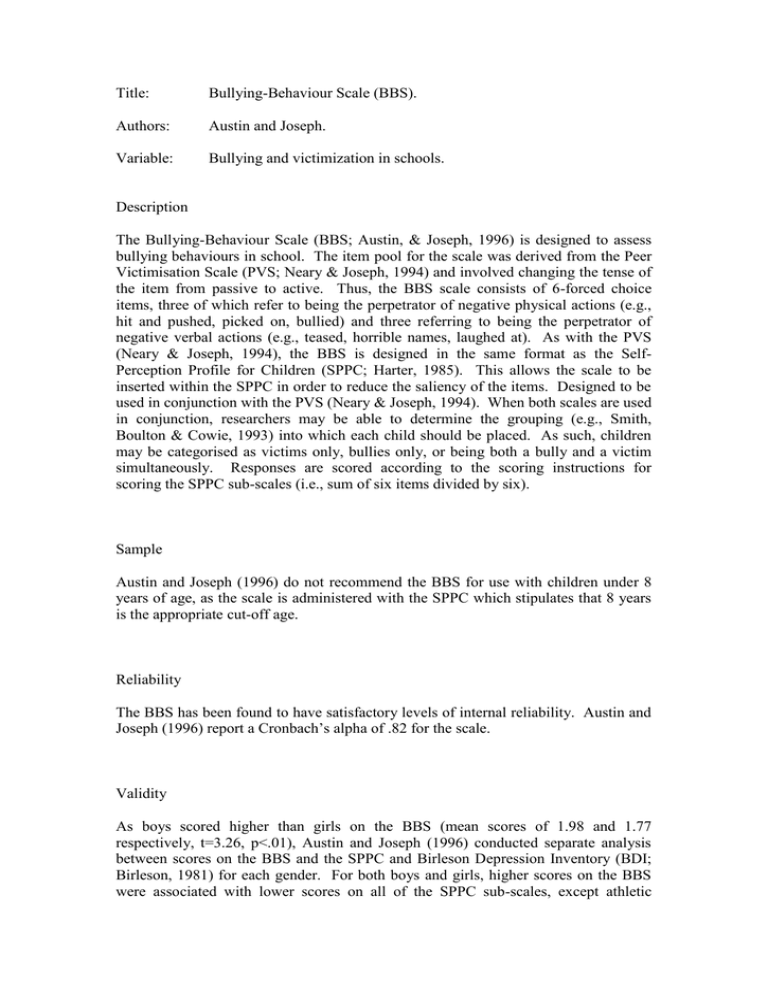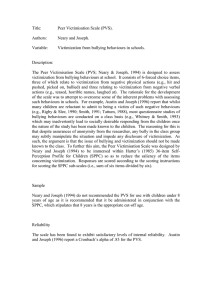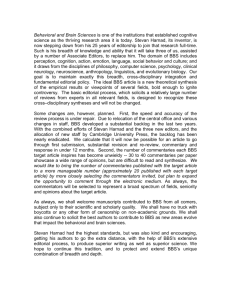Title: Bullying-Behaviour Scale (BBS). Authors:
advertisement

Title: Bullying-Behaviour Scale (BBS). Authors: Austin and Joseph. Variable: Bullying and victimization in schools. Description The Bullying-Behaviour Scale (BBS; Austin, & Joseph, 1996) is designed to assess bullying behaviours in school. The item pool for the scale was derived from the Peer Victimisation Scale (PVS; Neary & Joseph, 1994) and involved changing the tense of the item from passive to active. Thus, the BBS scale consists of 6-forced choice items, three of which refer to being the perpetrator of negative physical actions (e.g., hit and pushed, picked on, bullied) and three referring to being the perpetrator of negative verbal actions (e.g., teased, horrible names, laughed at). As with the PVS (Neary & Joseph, 1994), the BBS is designed in the same format as the SelfPerception Profile for Children (SPPC; Harter, 1985). This allows the scale to be inserted within the SPPC in order to reduce the saliency of the items. Designed to be used in conjunction with the PVS (Neary & Joseph, 1994). When both scales are used in conjunction, researchers may be able to determine the grouping (e.g., Smith, Boulton & Cowie, 1993) into which each child should be placed. As such, children may be categorised as victims only, bullies only, or being both a bully and a victim simultaneously. Responses are scored according to the scoring instructions for scoring the SPPC sub-scales (i.e., sum of six items divided by six). Sample Austin and Joseph (1996) do not recommend the BBS for use with children under 8 years of age, as the scale is administered with the SPPC which stipulates that 8 years is the appropriate cut-off age. Reliability The BBS has been found to have satisfactory levels of internal reliability. Austin and Joseph (1996) report a Cronbach’s alpha of .82 for the scale. Validity As boys scored higher than girls on the BBS (mean scores of 1.98 and 1.77 respectively, t=3.26, p<.01), Austin and Joseph (1996) conducted separate analysis between scores on the BBS and the SPPC and Birleson Depression Inventory (BDI; Birleson, 1981) for each gender. For both boys and girls, higher scores on the BBS were associated with lower scores on all of the SPPC sub-scales, except athletic competence and physical appearance. For bys only, higher scores on the BBS were associated with higher scores on the BDI. Location Austin,S., & Joseph, S. (1996). Assessment of bully/victimproblems in 8 to 11 yearolds. British Journal of Educational Psychology, 66, 447-456. Comments Although other questionnaires, such as the Bully/Victim Questionnaire (Olweus, 1978, 1991, 1993) are available to researchers interested in childhood bullying, the strength of the BBS, like the Peer Victimization Scale (PVS; Neary & Joseph, 1994), is in its brevity and structure. By being designed to slot into the SPPC, this not only helps to reduce possible manipulation of testing situations by bullies, but reduces the saliency of the items and allows for less socially desirable responding from the children. A further strength is that when used in conjunction with the PVS, which is similarly designed, assessments of categories of bullies and victims may be readily made. However, Austin and Joseph (1996) report that further work is required regarding the appropriateness of the chosen cut-off point for the purpose of classifications made with the BBS. Overall, the BBS is a useful instrument for any researcher attempting to assess accurately the levels of bullying behaviours in large samples of children. Although other instruments may be useful in assessing the extent and frequency of bullying behaviours in schools, the BBS addresses a real need for a discreet measure of bullying behaviours. Publications Austin,S., & Joseph, S. (1996). Assessment of bully/victim problems in 8 to 11 yearolds. British Journal of Educational Psychology, 66, 447-456. Harter, S. (1985). The Self-Perception Profile for Children: Revision of the Perceived Competence Scale for Children - Manual. Denver, CO: University of Denver. Neary, A., & Joseph, S. (1994). Peer victimization and its relationship to self-concept and depression among schoolchildren. Personality and Individual Differences, 16, 183-186. Olweus, D. (1978). Aggression in the Schools: Bullies and Whipping Boys. Washington, DC: Hemisphere. Olweus, D. (1991). Bully/victim problems among schoolchildren: basic facts and effects of a school based intervention program. In D.Pepler & K. Rubin (Eds.), The Development and Treatment of Childhood Aggression, (pp. 411-448). Hillsdale, NJ: Erlbaum. Olweus, D. (1993). Bullying at School: What We Know and What We Can Do. Oxford: Blackwell. Smith, P.K., Boulton, M.J., & Cowie, H. (1993). The impact of cooperative group work on ethnic relations in middle school, School Psychology International, 14, 2142. Reviewer Conor McGuckin, Christopher Alan Lewis, School of Psychology and Communication, University of Ulster at Magee College, Londonderry, Northern Ireland, BT48 7JL, U.K. CA.LEWIS@ULST.AC.UK





